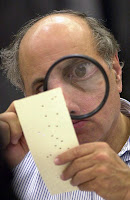
Wealthy industrialist
Tony Stark's new biopic is not the only thing making financial news today.
Last Thursday, the new CEO of Cardinal Health’s (CAH) distribution division described the company’s market share challenges with independent pharmacies following the disruption of controlled substances distribution at four locations. One day later, McKesson (MCK) announced a settlement with the DEA that temporarily suspends distribution of two controlled substances from two of its distribution centers.
See March’s DEA's Anti-Diversion Strategy blog post for background on the DEA’s strategy for combating diversion of legitimate controlled substances.
STRAIGHT TALK FROM CARDINAL’S GEORGE BARRETT
George Barrett, the new CEO of Cardinal Health’s Healthcare Supply Chain Services division, was refreshingly blunt in describing the need to “turnaround” the drug distribution business on last Thursday’s earning conference call.
Among other issues, Cardinal has been dealing with the fallout from controlled substance license suspensions in Washington, Florida, and New Jersey as well as limits on shipments to independents from Stafford, Texas. Last week, Cardinal disclosed that the disruption due to DEA compliance issues cost $15 million in the first calendar quarter of 2008.
Regular readers know that I’ve been critical of the way in which Cardinal handled this situation, especially the apparent lack of due process accorded to pharmacy customers. (See my exclusive interview with Washington pharmacist Richard Molitor.) I highlighted the marketplace impact in Cardinal's Customer Problems Deepen and have been discussing it privately with my clients for several months.
Here’s Mr. Barrett’s assessment of how Cardinal bungled the customer service aspect of DEA compliance:
“Our early efforts dictated that, at times we use something of a blunt tool to ensure that no diversion was occurring, rather than a precision instrument. We know that this has caused some disruption to our customers, particularly in the retail independent stage. We regret that and truly appreciate their support through a tough time. Having said that, we have lost some independent retail share over this and we’ve certainly made it a challenging environment in which to grow.”
I can’t yet say whether reality will follow the rhetoric. However, it’s encouraging that Mr. Barrett recognizes the challenges of the “enforcement” role that has been thrust upon the company by the DEA. No word from the company yet on whether he plans to fix these problems by flying around in red and gold armor.
MCKESSON SETTLES
McKesson (MCK) resolved its claim with the DEA for $13.25 million, an expected outcome given the company’s previous disclosures (described in New Signs of Rising Compliance Costs.) Florida got $7.5 million of the $13.25 million in civil penalties, ensuring that the state retains its infamous reputation.
A DEA press release describes McKesson’s alleged actions:
“Three McKesson distribution centers received and filled hundreds of suspicious orders placed by pharmacies participating in illicit Internet schemes, but failed to report the orders to DEA. They did so even after a Sept.1, 2005, meeting at which DEA officials met with and warned McKesson officials about excessive sales of their products to pharmacies filling illegal online prescriptions…As a result, millions of dosage units of controlled substances were diverted from legitimate channels of distribution.”
This Reuters story adds that McKesson must also temporarily suspend distribution of two drugs from two of its distribution centers. I presume that McKesson has learned some lessons from Cardinal’s troubles so the marketplace impact should be less severe.
For the record, I will remind you that “the settlement agreement is neither an admission of liability by McKesson nor a concession by the United States that its claims are not well founded.”
For the record, I will also tell you that Iron Man is an awesome movie.
---
Check out the new Health Wonk Review, a compendium of health care policy posts from around the web.
 You may find it hard to believe, but a fifth Cardinal Health (CAH) location is now under investigation for allegedly failing to report “suspicious orders” of controlled substances from its
You may find it hard to believe, but a fifth Cardinal Health (CAH) location is now under investigation for allegedly failing to report “suspicious orders” of controlled substances from its 








